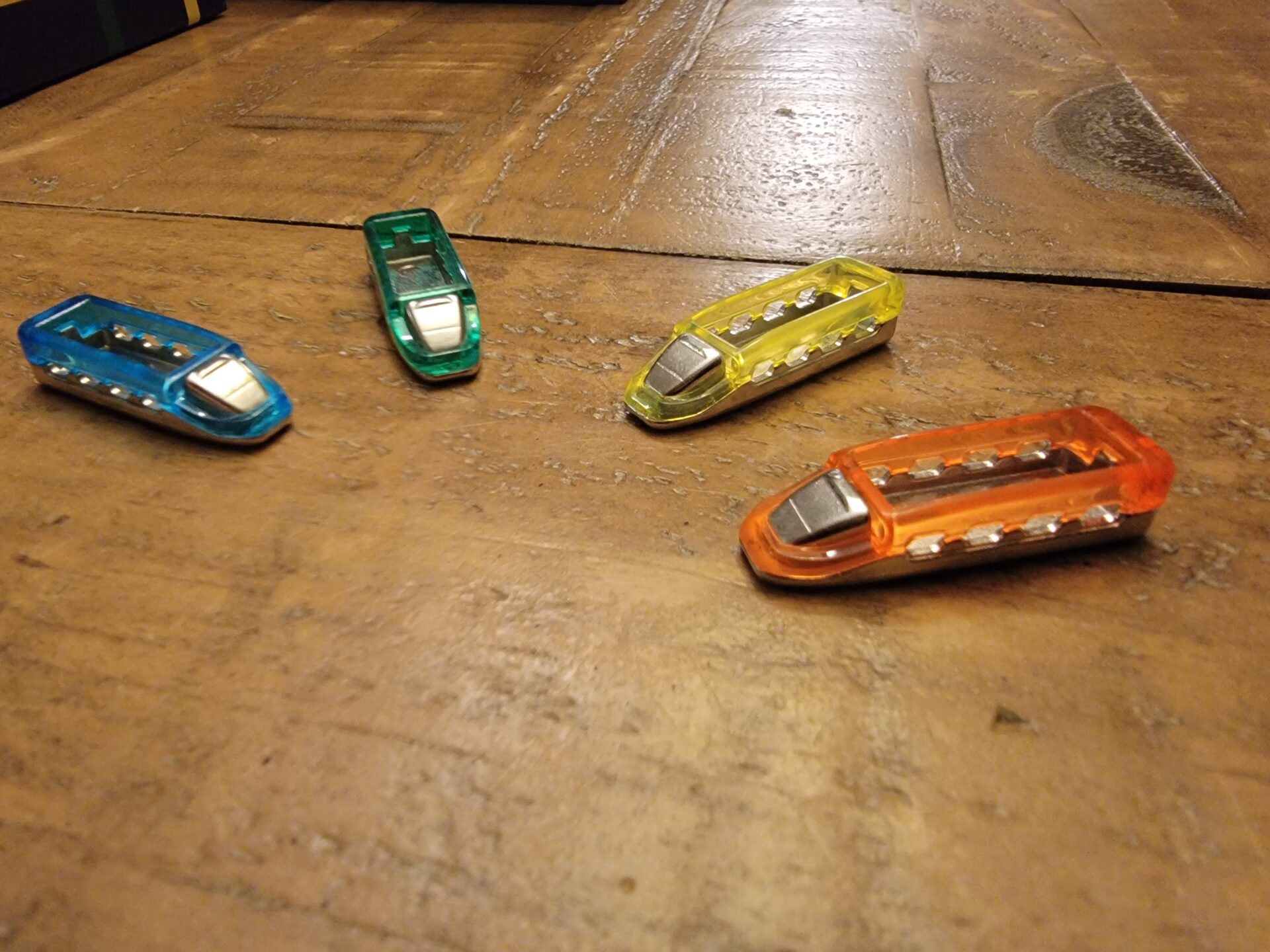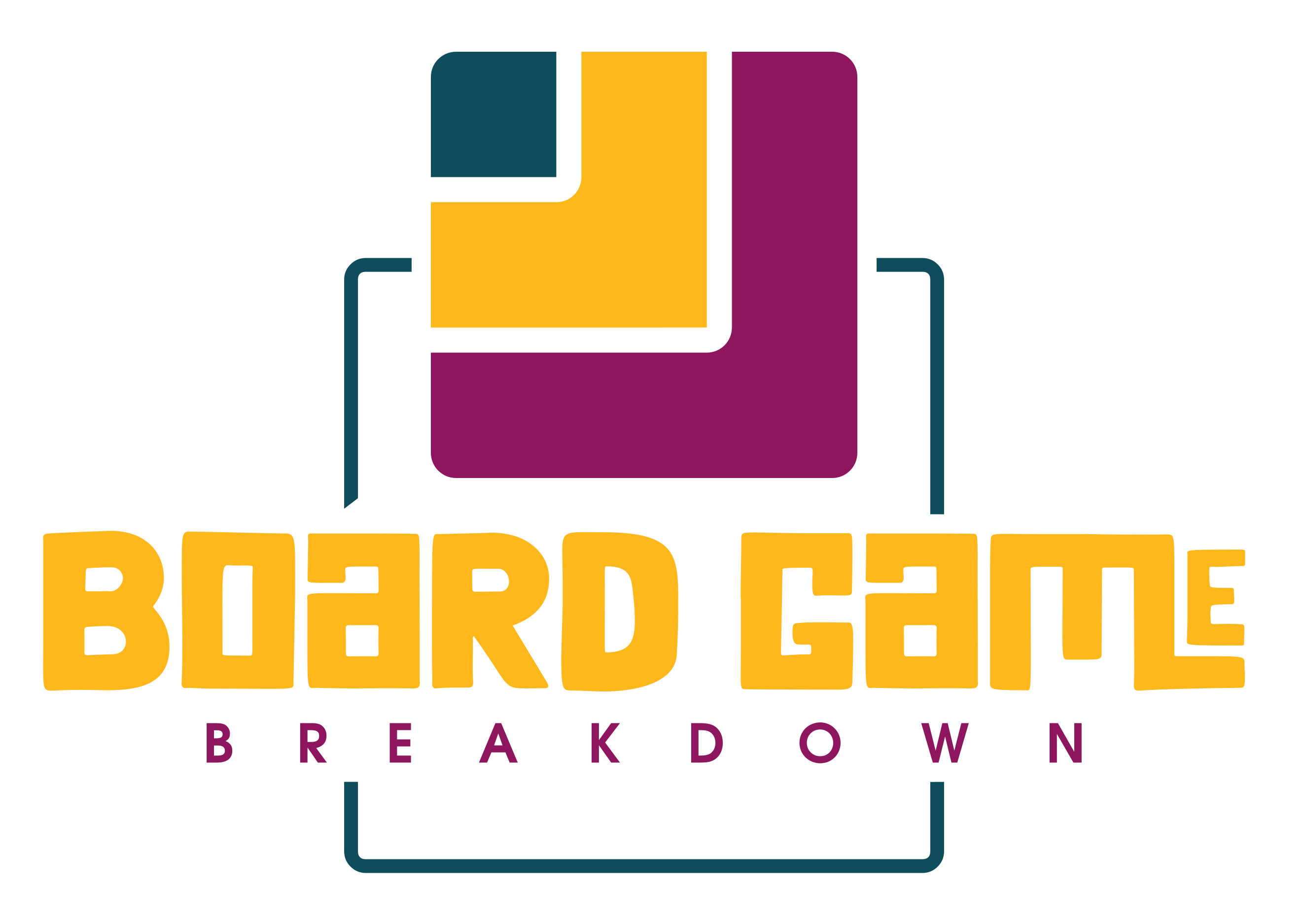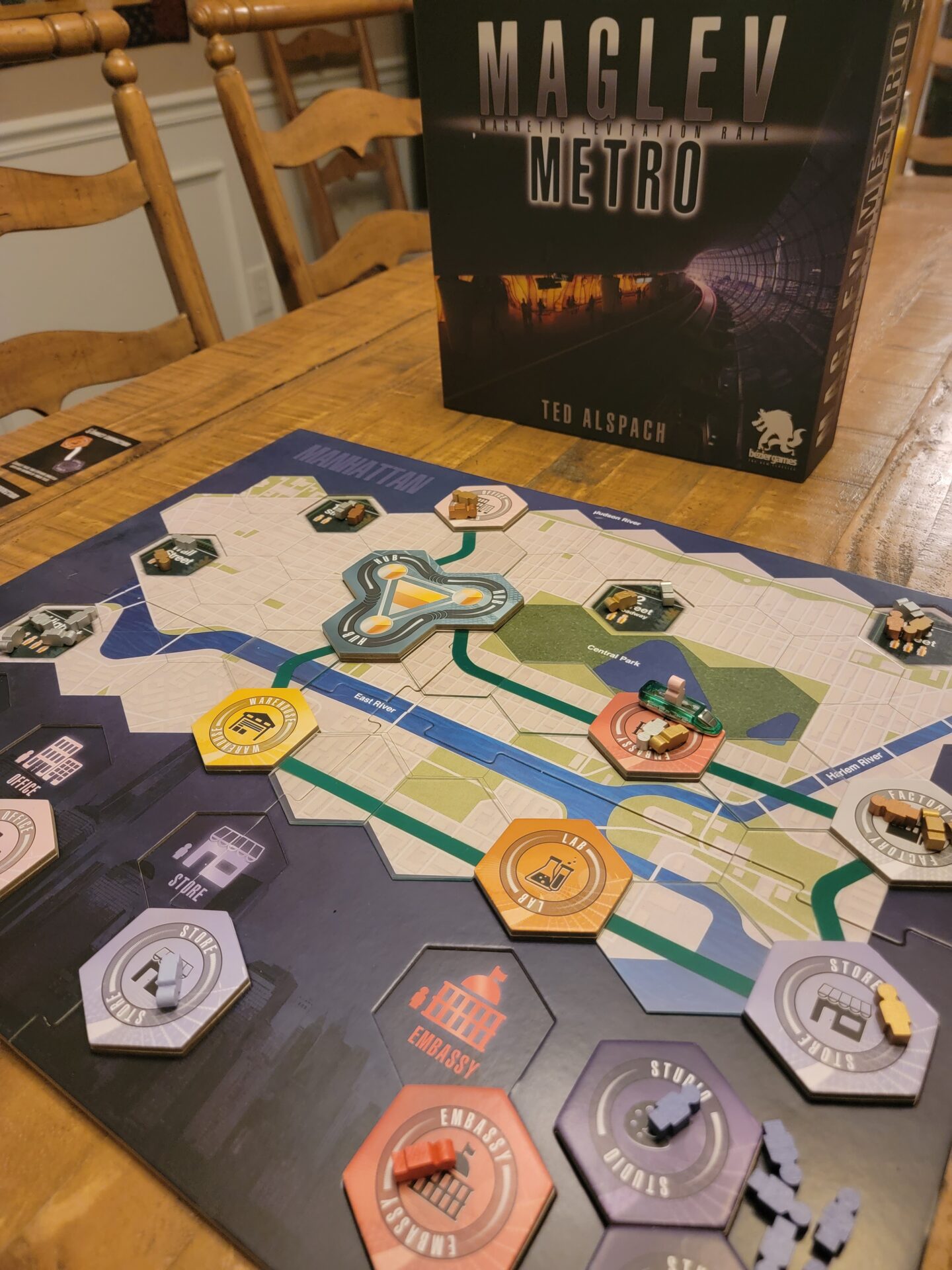
Name: Maglev Metro
Year of Release: 2021
Player Count: 1 – 4
Playing Time: 60 – 90 Minutes
Designer: Ted Alspach
Publisher: Bezier Games
Primary Mechanisms: Pick-Up and Deliver, Route Building, Tile Placement, End Game Bonuses
Weight (According to BGG.com): 2.80
Overview
“Another train game?”
Those were the words my wife spoke when I was telling her a little about my possible next purchase, Maglev Metro. Now, to add some context to this statement, we own exactly one single “train game” and we have owned this game (Ticket to Ride: Marklin Edition) since around 2007, a whopping 16 years. So, it’s not as if every time someone in the Solomon household opens a cabinet or a drawer, “train games” come gushing forth in perpetuity.
That being said, I can understand how a game series such as Ticket to Ride, which has multiple editions that can be found in big-box stores around the world, can have this effect on some people; making them think, “do we really need another train game?” Whether or not the answer is “yes” or “no,” in the case of Maglev Metro, the question isn’t even warranted as it is a much different animal than Ticket to Ride. The dueling mechanics of engine building and pick-up and deliver take front and center, though there is obviously route building because without it, your subway car wouldn’t get very far.
Read on to see if Maglev Metro is just the thing to deliver some fun and enjoyment to your next game night.
Rulebook & Components
I’ve found discussing the pros and cons of board game rulebooks to be one of the more challenging aspects of these write-ups. I think it’s valuable to include information on a rulebook and how it is presented but at the same time, I understand that we all learn differently and have different levels of reading comprehension. It is not entirely fair for me to state that a rulebook doesn’t do its job when that might just be my experience with it, but I do think there is something to be said for trying to explain why my experience might have been the way it was. What I’m trying to say here is, I don’t really like this rulebook!
Let me re-phrase that, “I didn’t really like this rulebook the first time through.” I remember coming away from it thinking that I didn’t really understand what constituted a turn in the game. I think the confusion came in from how they handled two aspects of the game within the rulebook. The first is, while each individual action is spelled out in detail, it was not very clear on what exactly took up one of your two actions you start with. Each players’ train has a certain Capacity that is treated just like every other action but this one doesn’t take up an action as part of your turn; more like a “passive” action but this could have been handled with more clarity in the rulebook.
My second point of contention is that the very first turn of the game has a slightly added step and while it is mentioned in the portion of the rulebook about the two maps, it read more like “here’s an example of what your first turns could look like.” This first turn has you place down the three (or more depending on player count) robots you start with onto your individual action board. Once complete, then you may take your first two actions. I remember getting to my second turn and wondering, “wait, do I pick these guys up and put them back down just like I did on the first turn?” Obviously, after playing and re-reading the rulebook, that is NOT how you play and it all feels much more natural in a real game but from just reading the rulebook, it felt a little messy.
On the flip side, the components that come with this game are absolutely excellent. The Map Board (featuring Manhattan on one side and Berlin on the other), Individual Player Boards, and the Station Tiles are nice and chunky, with bold colors that stand out as you play. Each players’ Track Tiles are printed on a clear piece of plastic allowing for multiple tracks to be built on the same hexagon without fear of being blocked. Not only does this allow for a beautifully looking and unique board at the end of the game, but it is also one of the standout features of the game. Each color also comes with a single Train Token that is nice and hefty, looking more like a kid’s toy than a simple component in a board game. You will also receive a deck of Objective Cards that, while not the most exciting component to look at, add to the cohesive feeling of the “near future” atmosphere brought out in all of the graphic design choices. Lastly, players will receive a whopping 104 Passenger Tokens, split between a multitude of types. There are 54 Robot Workers comprised of the Steel Builders, Gold Organizers, and Copper Tech Robots. The remaining 50 Passengers are considered Commuters: the Pink Professionals, Lilac Salespeople, Coral Diplomats, and Purple Artisans. I enjoy that the colors chosen for these contribute to a certain color scheme between the Passengers, but both the Lilac and Silver Passengers can be hard to differentiate as well as the Gold and Copper Robots. Someone on my social media feed did point me to the publisher’s website where they acknowledged the fact that the Copper Robots did not come out as planned and are offering a free replacement pack if you fork over the $3.00 for shipping. I took them up on the offer and they definitely look better but it is disappointing that they did not come in the game this way.
Setup and Gameplay

Setup in Maglev Metro is light, especially if you’re playing multiple sessions in a row. The activity that takes the most amount of time is removing a specific amount of Passengers dependent on the player count. If you were always playing solo or at the same player count repeatedly, you could negate this by just bagging up the extra Passengers so you’d never have to remove them. The next part of the setup revolves around placing the Station Tiles into their respective cutouts on the board and passing out the different player specific items (Train, Track Tiles, and Individual Player Board.) Lastly, you’ll pull Robot Workers out of the cloth bag at random, filling up the different Station Cutouts and then giving each player one of each of the colored Robot Workers. Setup for a solo game is slightly different, but I will put all my thoughts on the solo mode together, later on in the write-up.
As previously mentioned, the first turn has each player deciding where on their Individual Player Board to set their starting Robot Workers. The board is split into different areas with the main Actions being lined up down the middle of the board. To the left are two sections that can be filled in order to unlock extra Actions per turn as well as unlocking Commuter Stations and Commuter Tokens. The right side of the board is where Commuter Tokens will go in order to score Victory Points and complete Objectives. The twist here is that after your first turn, placing the Robots and generating your two actions, you can’t Adjust your Robot Workers on the board unless you use an action for this. So, why would you want to adjust the workers in the first place? The way the game is set up, the more Robot Workers that are housed in an action, the more of that action you can take per turn. An example of this would be that by default, a player can move to a single Station which takes up one Action. If the player took two Robot Workers and placed them into the section for the action Move, they could then start traveling up to and including three Stations away from where they started, again only using one of their Actions.
The beginning of the game focuses a lot on getting the Robot Workers into spaces that will help you most efficiently build out routes and unlock Commuters. If you’re keeping count, you’re probably thinking that this is going to be a tough ask with only three Robots. The good news is that it is easy enough to acquire new Robot Workers (and later on, Commuter Passengers.) The easiest way to do this is to build one of the Stations from their home in the board and you can then acquire a single Robot or Commuter that is placed on that Station during setup. But this only gets you one of these tokens, so that is where the actions Pick Up and Drop Off come into play. As you move your Train to different Stations, you’ll want to Pick Up Passengers and carry them to a Station matching their color. Once there, you’ll take the action to Drop Off and those Passenger tokens now become yours, free to be placed on your board and power more of your engine.
Unlike the Robot Workers, Commuters can’t be moved once they are on your board, so you have to be strategic at where you’re placing them. I truly enjoy the push and pull of the two main mechanics because if I spend too long powering my engine, I’ll end up with a ton of just Robots at the end of the game, that score me zero points. On the other hand, if I switch to picking up and delivering Commuters too quickly, odds are I’m not able to do many things on each action, which is going to tank my efficiency. The game has a nice puzzle of finding the middle ground between these and figuring out when the best time to switch is. With the clear Track Tiles being used, Player Interaction has to come in another form other than blocking each other’s routes. The game handles this in a few ways that I like. First, the Stations themselves are in very short supply so your opponent can easily build them in places on the Map that don’t meet your overall goals (not to mention, possibly wrecking your Objective Cards.) The second is the Passengers themselves. One of your Actions can be to Refill Stations with new Passengers from the bag but if both players have unlocked the same color Passenger, you could be setting up your opponent to sweep into the Station and Pick Up some of the Passengers you just pulled from the bag. None of these “gotcha” features feel too mean but they do bring enough interaction between players, which is fun.

Solo Mode Thoughts
The solo mode of Maglev Metro is quite a different beast from the standard multiplayer version. In multiplayer, the end game is triggered when at least one of each Commuter station is built and the bag is empty of Passengers. While this does act as a “clock” per se, you should have plenty of time to get a large amount of the Victory Point-yielding achievements accomplished. In the solo mode, the game lasts for as long as there are Passengers in the bag. Because a player is only removing three Passengers of each color to start the solo game, there will be a number of Robot Workers placed in the bag to start. Before each turn, the player will remove a Robot from the bag and once these are out, the game is over.

In effect, the game will last longer as you unlock more and more of the Commuter Tokens. This sounds all fine and dandy until you get to the scoring portion of the solo mode, and find out that each round you played goes against you as a negative point. This means that every time you unlock Commuters to extend the game, you better have a plan to overcome those negatives with points.
To be honest, I’m not good at all at the solo mode but I still find it fun and intriguing. I’ve come back to this almost 10 times in my first month of owning it as it just gives the player a great feeling of satisfaction when they see their hard work come to fruition and the well-oiled machine of their subway, humming along, swiftly picking up Passengers and dropping them off where they wish to go.
Conclusion
Maglev Metro came out of nowhere for me. Someone on Mastodon recommended it to me and though I had never even seen it mentioned, it looked like it was going to tick almost all of the boxes for me. It has been great fun to try to overcome with the two maps it ships with and the fact that they are putting out more dual-sided boards to add maps and mechanics to the game, is wildly underrated. If you like engine building, pick up and delivery, or you’re just looking for something that might play slightly different from other games in your collection, definitely check out Maglev Metro.
Rating
Ratings are based on 5 main criteria: rulebook, setup, components, art & graphic design, and gameplay. The first 4 criteria are rated 1 to 5 and the gameplay is rated 1 to 10. These scores culminate in an “overall satisfaction” score that is rated from 1 to 10. If the reviewed game has both a solo and multiplayer mode, I have assigned scores separately to give context to which mode we enjoy more.
Links
As an Amazon Associate I earn from qualifying purchases.
Amazon: Terraforming Mars – Ares Expedition board game

